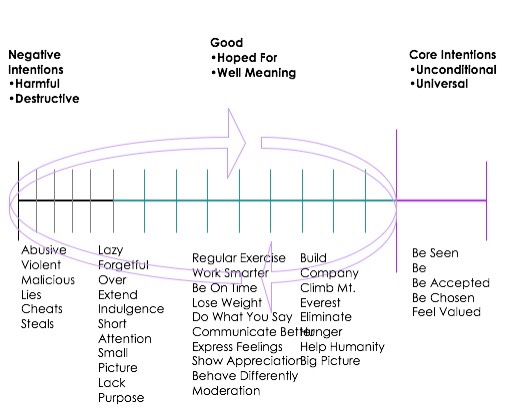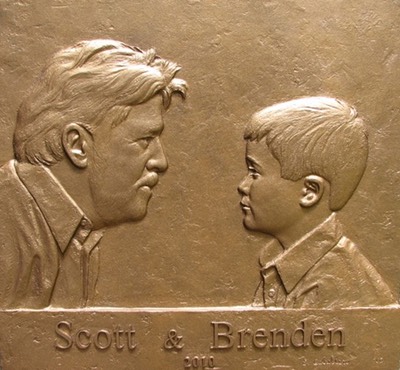Two types of Intentions: Conditional & Unconditional
World English Dictionary
World English Dictionary
intention (ɪnˈtɛnʃən)
-n
1. a purpose or goal; it is his intention to reform
2. law the resolve or design with which a person does or refrains from doing an act
Good intentions
Good intentions are CONDITIONAL. They are open to the interpretation, conditioning, experience, opinions, beliefs, culture or the politics of those involved. There are always exceptions or differences of opinion regarding good intentions, i.e., “Should we feed the hungry or make available means to that end?”
Core Intentions
We all have an intrinsic need to feel seen, understood, accepted, chosen and valued by others. These are the Five Intentions and are always UNCONDITIONAL. They remain the same for everyone, everywhere, at any time - with no exceptions! The hermit is in relationship with the towns people weather he communicates or not. He is seen, understood, accepted, chosen and valued in some way by each citizen. We all hope to feel these Five Intentions when in conversations with business colleagues and in personal relationships. It is our primary motivation for communicating. When people are not being seen, understood, accepted, chosen or valued in relationships, Five Intentional Language is absent and relationships decline.
So we all grow up imperfect. Our relationship model may be missing a few elements, like the struggling plant, so we use what we have.
People and organizations are their core intentions, regardless of their reactive verbal & non-verbal behavior. The Five Intentions are to be seen,understood, accepted, chosen and valued. These Five Intentions are the reasons we work, play, love, have children and start companies. Five Intentions respond to Intentional language that brings forth into awareness the felt sense of being seen, understood, accepted, chosen and valued. Intentional language is responsive, creates results and pulls people into conversations. No one is holding back a better model for relationship. When people or organizations are not being seen, understood, accepted, chosen and valued, intentional language is absent.
Continuum of Intentions
Five Intentions are distinct from everyday or “good” intentions. Five Intentions are unconditional. Five Intentions are not open to interpretation and there are no exceptions.
Good intentions are conditional. Good intentions are open to the interpretation, conditioning, experience, opinion, and belief, culture or politic of those involved. There are always exceptions to good intentions.
The following is a spectrum of intentions, thought provoking but not comprehensive. Intentional language uses both these conditional and unconditional intentions to speak directly to behavior and inject value into a conversation.
A.
Conditional Good Intentions
1. These run along a continuum from unconscious intentions to verbalized hopes, dreams & beliefs.
2. Unconscious Intentions – These are intentions below the level of consciousness (words that hurt, behaviors that insult and things we say but are not aware of the impact on other’s feelings).
3. Evil Intentions- Inwardly focused, dark hardwiring that has been so wounded that feelings are only felt when others are in pain or experiencing a state of loss or hopelessness (masochistic, psychopathic, sociopath, sadist behavior; without conscience).
Abusive
Violent
Malicious
Lies
Cheat
Steal
4. White Lie Intentions - That intend no harm, but are not the true intention of the person who uses them (“I will call you!” “We will get back to you!” “The check is in the mail!” and the whole range of sarcastic humor).
Lazy
Forgetful
Over Extend
Indulgence
Short Attention
Small Picture
Lack Purpose
5. Systemic Agreement Intentions - The agreements we have with people in general (to stop at stop signs; to give correct change; to give accurate directions; etc).
Tolerance
Be On Time
Do What You Say
Moderation
Show Appreciation
Reliable
6. Hopes, Dreams & Belief Intentions – These are hardwired hopes, dreams and beliefs we have regarding others. This includes our feelings concerning marriages, partnerships and communities and how they will work out over time (“We will be married for ever!” “This car is a gem!” “Let’s meet every week to talk!” “We all want our intentional community to last forever!” etc).
7. Well-meant intentions without real guarantees.
Regular Exercise
Work Smarter
Lose Weight
Communicate Better
Express Feelings
Behave Differently
Build Company
Climb Mt. Everest
Eliminate Hunger
Help Humanity
Big Picture
B.
Five Intentions
These are the feelings that we associate with being:
Seen,
Understood,
Accepted,
Chosen and
Valued through others language and behavior.
These feelings are present whenever another person has the skill to use Intentional Language in conversation. This skill allows us to have the capacity to acknowledge and see around distractive behavior and then to speak directly to the person’s Core Intentions.
Five Intentions are at one end of the continuum and are the intentions that apply to all people, without exception. These intentions relate to a state of feeling whole, energetic and valued. When present, all is well in relationship, work and life. When absent, all life is a struggle.
The Range Of Intentions
Conditional Good Verses Unconditional Five Intentions
Intentional Language:
Is central to all of the tools described in this chapter. The OREO technique, Generous Listening, Questioning Questions, Push or Pull Questions and Listen To or Solve problem solving are examples.
Is a way of addressing a person’s behavior and at the same time speaks to a person’s intentions.
Is a dramatic way to affect the way another people listen and behave, regardless of our history with that person.
Makes a person feel pulled into the conversation.
Sets up and maintains an open environment to pursue a mutually beneficially outcome.
Five Intentional Language:
Speaks to the desire of each of us to be seen, understood, accepted, chosen or valued by others.
Gives us the ability to seen, understood, accepted, chosen or valued others.
Is rooted in early childhood conditioning which creates our model of how people in our family are in conversation about relationship.
When a person, or a whole organization, is not feeling seen, understood, accepted, chosen or valued, Core Intentional Language is absent and relationships consume excessive amounts of time and energy.
We want this from business colleagues and personal relationships.
It is our prime motivation for communicating.
These Five Intentions are unconditional as they are the same for everyone, everywhere - with no exceptions!
On a personal note, I have heard many word substitutes for the five Core Intentions. It matters little if a different word is used, as long as the meaning is not lost in the new word’s definition. The five Core Intentions have withstood the test of time, culture and preference.
We all have an intrinsic need to feel:
Seen
Understood
Accepted
Chosen
Valued
Five Unconditional Intentions
Seen
- Physically seen as well as an emotional feeling of “I exist!” A feeling that says I have been identified so I must exist. I feel Seen when I am called by name by another person.
“Hi Scott!”
Understood
- A physical feeling left when I am asked multiple, detailed questions about what I am talking about.
I feel understood when I am not interrupted by the listener’s personal views, beliefs or behaviors, but I’m asked more questions.
“Tell me the best part of your vacation Scott. What did you do, what did you see and would you go again.”
Acceptable
- A physical feeling of integrity & wholeness remaining after someone communicates that I am acceptable, as is – all of my positive & negative attitudes, beliefs, appearance and the ways I express myself in general.
“I appreciate you just the way you are. I like the way you are open to learning new ways of being in partnership. I like the way you laugh at your own mistakes.”
Chosen
- A physical feeling of ’beginning to be filled up’ after I have been selected, singled out or spoken of as unique.
“You were the first one we thought of when a need came up to fill this job position.”
Valued
- A physical feeling I have of ‘always being full,’ energetic & abundant with productive energy.
A fullness that does not diminish since its source - being seen, understood, accepted, chosen and valued from others - is known and available.
“Even though I lost the account, since the window of opportunity has passed, I still feel fulfilled because of all that I have learned and can use in the future.”
Cycle of Intentions
Continuum of Conditional & Unconditional Core Intentions
Unconditional Core Intentions are the feelings that we associate with being seen, understood, accepted, chosen and valued by others - through their language and behavior. These feelings surface whenever another person has the skill to use Intentional Language in conversation. This is the ability to see around behavior and speak directly to their intentions. At one end of the continuum are the Intentions that apply to all people, without exception. These intentions relate to a state of feeling. When present, all is well in relationship, work and life. When absent, all life is a struggle.
Conditional Intentions run along a continuum from Unconscious Intentions to Hopes, Dreams & Beliefs.
Unconscious Intentions - Intentions below the level of consciousness( words that hurt; behaviors that insult; the insane).
Evil Intentions- Inwardly focused, dark hardwiring that is able to feel only when others are in pain or a state of loss or hopelessness (masochistic, psychopathic, sociopath, sadist behavior; without conscience ).
White Lies - That intend no harm, but are not the true intention of the person who uses them ( “I will call you!” “We will get back to you;” The check is in the mail, and sarcastic humor.”).
Systemic Agreements - The agreements we have with people in general (to stop at stop signs; to give correct change; to give accurate directions; etc ).
Hopes, Dreams & Beliefs - In the midrange are hardwired hopes, dreams and beliefs we have regarding others. This includes our feelings regarding marriages, partnerships and communities and how they will work out over time ( we will be married for ever; this car is a gem; let’s meet every week to talk; we all want our intentional community to last forever; etc ).
Copyright © 2020 Scott Taylor Consulting All Rights Reserved.

![[Click for IPA pronunciation guide]](http://static.sfdict.com/dictstatic/g/d/dictionary_questionbutton_default.gif)